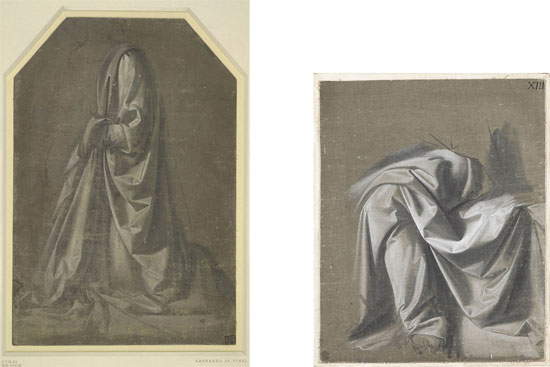One of the lesser-known strands of the great Leonardo da Vinci’s production is drawing on canvas, which, although not practiced as frequently as drawing on paper, was nevertheless sometimes experimented with by the artist. One of the first biographers of Leonardo to describe his process is Giorgio Vasari, who, in the chapter of his Lives devoted to the genius of Vinci, writes: “because his [Leonardo’s] profession wanted it to be painting, he studied a great deal in natural portraits, and sometimes in making medals, of earthen figures, and on those he put soft rags buried, and then with patience he put himself to portray them over certain very thin canvases of rensa or used draperies, and he worked them in black and white with the tip of the brush, which was a miraculous thing, as some of them still testify, which I have by his hand, in our book of drawings.”
What did Leonardo da Vinci do, in essence? He procured, or created himself, terracotta models (the “earthen figures” mentioned by Vasari), covered them with wet, earth-covered cloths so that they would adhere better to the mannequin and thus create more natural folds (the “buried soft rags”), after which he used rensa or linen cloths (“pannilini,” i.e., linen cloths) and, soaking his brush in ink, fixed on the canvas what he saw before him. The rensa mentioned by Vasari is nothing more than a fine, very fine linen fabric named after the city of Reims, France, the place of origin of rensa. It was used mostly in the production of high-quality linens, but because of its ability to soak up ink with great ease, and because of the precision with which artists could work on this medium, rensa was also often used for drawing. The use of linen was also due to the fact that, compared to paper, it is obviously much more durable, and lends itself better to the use of tempera: artists could therefore experiment, on linen, with effects to be applied later to the finished painting. In Verrocchio’s workshop, where Leonardo completed his apprenticeship, drawing on linen canvas was widely used (although paper still remained by far the preferred medium): however, few surviving examples of studies produced with this technique remain.
In fact, only sixteen sketches on linen canvas attributed to Verrocchio’s workshop have been preserved. At the exhibition Leonardo da Vinci. 1452-1519 currently underway in Milan (Palazzo Reale) until July 19 and produced by Skira together with the City of Milan, it is possible to observe two examples, created by the hand of Leonardo. Let’s see them both, in order to better understand how they were produced, for what purposes, and why Leonardo sometimes preferred linen to paper. With a necessary clarification: not all critics agree in attributing the drawings to Leonardo. Unfortunately, there are no documents that can confidently certify their authorship (and they probably never existed), and the history of their passage through the various collections is often terse and convoluted.
As can be clearly seen, drawing on linen canvas meant obtaining a result very similar to painting, certainly closer to the final result than the same study made on paper.This is why Leonardo, as well as other artists working in Verrocchio’s workshop, used this technique. Some scholars have hypothesized that these works were not preparatory studies for paintings, but were simply exercises that were meant to be used by students to become familiar with the depiction of drapery. Here, then, is another argument that would explain why linen was used instead of paper: and then, since it was a technique closer to painting, it was more demanding than drawing on paper, and therefore particularly suitable for preparing pupils.
 |
| Leonardo da Vinci, Drapery Study (c. 1470; Brush and sepia-gray ink raised with white lead on linen canvas prepared in gray; 240 x 193 mm; Paris, Fondation Custody, Collection Frits Lugt) |
 |
| Leonardo da Vinci’s two studies on display in Milan. In placing them side by side, we have tried to respect the actual proportions between the two drawings as much as possible. |
It was mentioned just above that critics disagree in attributing the drawings to Leonardo. Moreover, according to many scholars, the works that make up the corpus of drawings on canvas attributable to Verrocchio’s workshop would have been made by different artists. Among those who have argued for an attribution to Leonardo da Vinci we must mention Françoise Viatte, who, on the occasion of an exhibition at the Metropolitan Museum in New York between 1989 and 1990, where the drawings were exhibited, asserted that, according to her opinion, all the drawings in the group should be attributed to the hand of Leonardo: this is mainly because of their very high precision, which no artist of the time, not even those who studied with him from Verrocchio, was able to achieve. Especially if we think about the fact that others such as Ghirlandaio and Lorenzo di Credi were, at the time, “students” like Leonardo, but the genius from Vinci mastered the techniques of painting as if he had already been an expert artist: something that his contemporaries were not yet able to do.
Unfortunately, there are no elements to arrive at definitive conclusions. But it is unquestionable that, at least the two drawings on display at the Milan exhibition, show a finesse of execution, precision and rendering that only a great artist can offer. And the result is innovative and surprising: one only has to see it to realize it.... !
Warning: the translation into English of the original Italian article was created using automatic tools. We undertake to review all articles, but we do not guarantee the total absence of inaccuracies in the translation due to the program. You can find the original by clicking on the ITA button. If you find any mistake,please contact us.